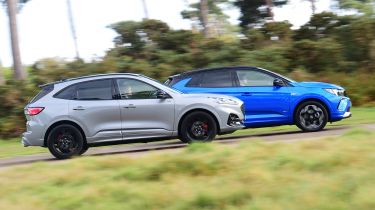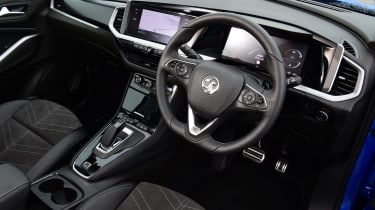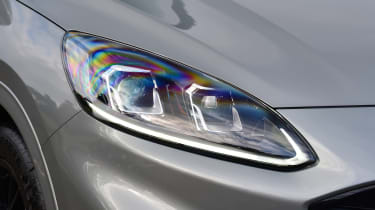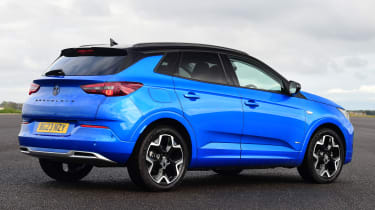Ford Kuga vs Vauxhall Grandland: a mid-size SUV skirmish
SUVs are the must-have models for buyers these days. How do our rivals’ mid-size offerings shape up?
Ford and Vauxhall remain fiercely competitive in the family hatchback class, but neither quite tops the rankings (in sales or ability) when it comes to their mid-size SUV offerings.
The Kuga and the Grandland each fly below the radar, with alternatives such as the Hyundai Tucson, Kia Sportage and Skoda Karoq stealing the limelight. But within a crowded market, the Kuga has unique appeal, which makes it our favourite here.
There’s a recurring theme among all of the Fords on this list, and it’s that they’re fantastic to drive. Most cars in the family SUV class are set up to merely deliver safe, predictable handling; Ford has achieved that, but sprinkled a little of the magic you’ll find in a Focus on the Kuga, too.
Under the bonnet, there’s a choice of three powertrains. At one end of the spectrum there’s a 1.5-litre turbo petrol engine with 148bhp, and at the other a 222bhp plug-in hybrid.
Between them sits this full-hybrid model. The transition between petrol and electric modes isn’t as smooth as in some HEVs, but linear acceleration and a muted engine note mean that once it’s in the groove, performance is decent enough. Better still, it didn’t take too much effort for it to top 50mpg in mixed driving – an excellent number for a car of this type.
Used - available now

2022 MINI
5-Door Hatch
28,571 milesAutomaticPetrol2.0L
Cash £19,587
2023 Jaguar
XF
30,114 milesAutomaticPetrol2.0L
Cash £28,950
2021 BMW
iX3
37,202 milesAutomaticElectric
Cash £23,787
2021 BMW
iX3
66,653 milesAutomaticElectric
Cash £20,287Elsewhere, the Kuga is more of a mixed bag. The cabin is functional, but feels cheap when compared with the Grandland, and it still soldiers on with an older version of Ford’s SYNC infotainment system, rather than the slick touchscreen you get in the Focus. Further back, rear kneeroom is fantastic – one of the roomiest cars in its class, and there’s a sliding rear bench to boost space if needed – but headroom is among the tightest in this segment. While comfort is a subjective thing, we didn’t find the seats as supportive as those in the Grandland, either.
Once again, the Vauxhall manages to feel just a little more special inside, with a widescreen infotainment system sitting beside a similarly large digital driver’s display.
Headroom is excellent, and even though kneeroom can’t match the Kuga’s, it’s still spacious for four or even five adults. At 514 litres, the boot is fairly generous, but that’s only for pure internal-combustion versions. Go for a plug-in hybrid – like the car here – and that figure drops to an underwhelming 390 litres.
In the case of this car, that PHEV powertrain takes the form of a 1.6-litre turbocharged petrol and a 108bhp electric motor. The stats are remarkably similar to the Kuga’s plug-in option. Both produce 222bhp (although the Ford uses a larger 2.5-litre non-turbo petrol to achieve this) while both cars’ batteries store around 14kWh of energy.
WLTP EV ranges of up to 41 miles in both allow them to just sneak into the eight per cent Benefit-in-Kind bracket for company car taxpayers. In contrast to the Kuga, the Grandland feels a little flat-footed, and there are alternatives that are more comfortable and refined.
Results
Our choice: Ford Kuga
The Kuga wins here mainly due to its unique talents in this class. While both of these crossovers are very capable, the way the Ford drives makes it stand out from the vast range of rivals. It pairs that appeal here with a frugal hybrid powertrain, decent practicality and a price that’s competitive with the class best.
| Pros | Cons |
| Fabulous to drive | Dated cabin and tech |
| Rear legroom | Rear headroom |
Runner up: Vauxhall Grandland
Although the Grandland doesn’t have any significant flaws, its downfall stems from the fact that there are other rivals that manage to offer many of the same things, but to an even better standard. Practicality, safety and powertrain choices all count in its favour, but while it’s a dependable family SUV, it isn’t a winner here.
| Pros | Cons |
| Standard equipment levels | So-so boot space |
| Several plug-in hybrid options | Underwhelming to drive |
Figures
| Ford Kuga ST-Line X Edition FHEV |
Vauxhall Grandland Ultimate 225 PHEV | |
| On-the-road price | £39,825 | £44,160 |
| Powertrain | 4cyl in/2,496cc, 1.1kWh batt. | 4cyl in/1,598cc, 14.2kWh batt. |
| Power/torque | 187/200bhp/Nm | 222bhp/360bhp/Nm |
| Transmission | CVT auto/FWD | 8-speed auto/FWD |
| Length/wheelbase | 4,614/2,710mm | 4,477/2,675mm |
| Height/width | 1,678/1,883mm | 1,609/1,856mm |
| Boot capacity (seats up/down) | 411/1,481 litres | 390/1,528 litres |
| Kerbweight/payload/towing weight | 1,701/514/1,600kg | 1,807/503/1,250kg |
| Turning circle/spare wheel | 11.5 metres/£150 | 10.7 metres/repair kit |
| Basic warranty/recovery | 3 yrs (60k)/1 yr | 3 yrs (60k)/1 yr |
| Driver Power manufacturer position | 28th | 24th |
| NCAP: Adult/child/ped./assist/stars | 92/86/82/73/5 (2019 ) | 84/87/63/60/5 (2017) |
| 0-62mph/top speed | 9.1 secs/122mph | 8.9 secs**/140mph |
| WLTP economy/EV range | 50.4mpg/NA | 201.8mpg/36 miles |
| Claimed CO2/tax bracket | 129g/km/30% | 32g/km/12% |
| Airbags/Isofix/parking sensors/cam. | Seven/two/f&r/yes | Six/three/f&r/360 |
| Lane keep/blindspot/AEB | Yes/£1,100*/yes | Yes/yes/yes |
| Climate control/cruise control | Yes/yes | Yes/adaptive |
| Leather/heated seats/metallic paint | No/yes/£600 | No/yes/£600 |
| LEDs/keyless entry & go/pwr tailgate | Yes/yes/yes | Yes/yes/yes |
| DAB/connected services | Yes/yes | Yes/yes |
| Satellite navigation/digital dash | Yes/yes | Yes/yes |
| Wireless charge/CarPlay/Android Auto | £150/yes/yes | Yes/yes/yes |











